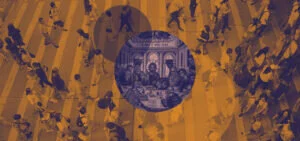It has been a common (though not universal) assumption in the history of Christian thought that humans were created immortal, and only lost their immortality with the entrance of death as the consequence for sin.The 1566 Catechism of the Council of Trent, which forms the basis for Catholic doctrine, asserts that the first human (in Genesis 2) was “so created and constituted in body as to be immortal and impassible”; see The Catechism of the Council of Trent Published by Command of Pope Pius the Fifth, trans. J. Donovan (New York: Catholic Publication Society, 1829), 30. The idea of original human immortality is also commonly found in the theology of the Protestant church, both among pastors and laity.
This is, however, a misreading of the biblical data, which suggests that humans were created mortal with the possibility of attaining eternal life—a possibility that was lost through sin and is now realized in Jesus Christ.
The Warning about Death in Genesis 2
On the face of it, however, the claim that humans were created mortal seems to be contradicted by the warning about death in Genesis 2, where YHWH God commands the newly created human being that he must not eat from the tree of the knowledge of good and evil, because “in the day that you eat of it you shall surely die” (Gen. 2:17).“You shall surely die” in Gen. 2:17 represents a particular Hebrew formulation that repeats the verbal root in an infinitive followed by a finite form of the verb (“to die you will die”). The result is emphatic. Thus Robert Alter translates it as “doomed to die” (Alter, Genesis: Translation and Commentary [New York: Norton, 1996], 8). This warning takes on poignancy in contrast to the presence of the tree of life in the midst of the garden (Gen. 2:9). We will come back to the tree of life, but here we need to discern what sort of death is intended by God’s warning.
One possible meaning of death is simply the ending of biological life, such that when the humans eat of the prohibited tree they would literally fall down dead. The fact that they don’t die in this sense has suggested to some interpreters that the snake was right to say “you surely will not die” (Gen. 3:4).R. W. L. Moberly insightfully addresses this question, moving in a direction similar to my own, in “Did the Serpent Get it Right?” Journal of Theological Studies 39 (1988): 1–27.
Alternatively, death could refer to the introduction of mortality (God placing a limit on life), which would be congruent with the idea that humans had been created immortal. However, this interpretation is at odds both with how Genesis 2–3 portrays human creation and with the tenor of the rest of Scripture.
Humanity Made from the Dust of the Ground
According to Gen. 2:7, after God formed the human being (ha’ādām) from the dust of the ground, God breathed into him the breath of life and the human became a nepeš ḥayyāh, which the KJV translates as “a living soul.”This similarity suggests that if humans were created immortal, then so were animals. Although this used to be a common Christian claim, it is becoming rarer to think that animal death began with the fall. Instead of having a “soul” (as later Christian tradition came to affirm, via Plato), a human in the Old Testament is a “soul,” a nepeš, indeed a living nepeš. A good translation for nepeš ḥayyāh would be something like a “living organism.”To use “living” (ḥayyāh) with nepeš is not redundant, since a dead nepeš refers in the Bible to a corpse, an organism after the life has left it (Num. 5:2; 6:6; 9:6–7).
The fact that both humans and other animals are created from the ground and described as nepeš ḥayyāh (Gen. 2:7, 19) indicates a fundamental similarity between them. This similarity suggests that if humans were created immortal, then so were animals. Although this used to be a common Christian claim, it is becoming rarer to think that animal death began with the fall. Apart from the fact that only human death is explicitly mentioned in Gen. 2:17, there is also the conundrum of trying to figure out what exactly qualifies as an animal. Were sponges and corals originally immortal?And what about other living things, like plants, bacteria, and viruses?
But beyond the terminology of nepeš ḥayyāh, we should note that the first human was formed from “the dust of the ground” (Gen. 2:7). The point is not that the first human was uniquely formed from dust (and the second from his rib), whereas all subsequent humans are born from their mother’s womb. Rather, “dust” is a biblical metaphor for transience and mortality.
The significance of “dust” can be seen not only in Gen. 3:19 (“you are dust, and to dust you shall return”), but also in Ps. 103:14, which affirms human mortality using the very words “formed” and “dust” from Gen. 2:7. Psalm 103 is instructive in that it contrasts short-lived, transient humanity with God’s everlastingness and affirms that not just the first man, but all people (“we”), are formed from dust. Likewise, Psalm 90 contrasts the everlasting God with the short human life span (seventy or eighty years; 90:10) and describes death as God turning people “back to dust” (Ps. 90:3). Thus, another psalmist can plead that God spare his life, accompanied by the poignant question: “Will the dust praise you?” (Ps. 30:9) And to be raised from “the dust of the earth” is how resurrection is spoken of in the Old Testament (Dan. 12:1).The dust metaphor is applied to all living things in Psalm 104, which notes: “when you [God] take away their breath, / they die and return to their dust” (Ps. 104:29). This makes sense of the expression “the dust of death” in Ps. 22:15, as well as a reference to “all who go down to the dust” (Ps. 22:29).
In the New Testament, Paul calls Adam a “man of dust,” which refers to his having been created mortal (1 Cor. 15:47–49), in contrast to the immortality of resurrection that comes through the risen Christ, the second Adam. Even John Calvin understood that the first humans were created mortal. Commenting on “you are dust, and to dust you shall return” (Gen. 3:19), he notes that “what God here declares belongs to man’s nature, not to his crime or fault.”John Calvin, Commentaries on the First Book of Moses, Called Genesis, vol. 1, trans. John King (Grand Rapids: Eerdmans, 1948), 180 (emphases in original). For Calvin, who believed in an immortal soul, the punishment meant that we do not directly proceed from death to eternal blessedness (as would have been the case if Adam never sinned), but instead experience the violent sundering of soul and body.
Death as the Constriction of Life
But if the warning about “death” in Gen. 2:17 does not signify either falling down dead on the spot or the acquisition of mortality, what does it mean?
An answer to this question may be found in the broader biblical worldview, which contrasts the paths of life and death that are set before Israel in the Torah and wisdom literature. In Deuteronomy we read: “See, I have set before you today life and prosperity, death and adversity” (Deut. 30:15), with the outcomes also described as blessing and curse (Deut. 30:19). Likewise, Israel’s wisdom traditions portray the opposing paths of the righteous and the wicked, with their contrasting outcomes of flourishing and destruction (Prov. 2:20–22; Psalm 1). For a more extensive discussion of the two paths, and the relation of wisdom to life, see J. Richard Middleton, A New Heaven and a New Earth: Reclaiming Biblical Eschatology (Grand Rapids: Baker Academic, 2014), chap. 5: “Earthly Flourishing in Law, Wisdom, and Prophecy.”
The contrast between life and death in these texts is not reducible to the difference between mere existence and the extinction of existence; nor does it refer to immortality versus mortality. Rather, the focus is on the quality of life, whether positive or negative.
On the one hand, the Scriptures exhort us to reverence for and obedience to God, which is the path of wisdom and results in blessing and shalom (Lev. 26:3–13; Deut. 28:1–14). This is symbolized in the garden narrative by “the tree of life,” from which humans are encouraged to eat (Gen. 2:9). And it is not coincidental that wisdom is described in Proverbs as “a tree of life for those who lay hold of her” (Prov. 3:18). Life is here equivalent to the abundant life that Jesus promises (John 10:10).
On the other hand, we are warned against the idolatrous rejection of God’s ways, which is the path of folly and results in a life that is deformed and plagued by corruption and calamity, leading ultimately to exile from the land (Lev. 26:14–39; Deut. 28:15–68). Hence, the dire warning about “death” in the garden narrative (Gen. 2:17).
It is the sense of death as the antithesis of flourishing that allows the writer of Psalm 88 to claim that he is already in the grave (Ps. 88:3–6). Death has begun to encroach on life; corruption has compromised shalom. In a similar vein, when Jacob thought Joseph was dead, “he refused to be comforted, and said, ‘No, I shall go down to Sheol to my son, mourning’” (Gen. 37:35). Jacob was not planning suicide. Rather, the quality of his life had been compromised; life had become as death to him.On the role of Sheol in describing the constriction of life, see Jon D. Levenson, Resurrection and the Restoration of Israel: The Ultimate Victory of the God of Life (New Haven: Yale University Press, 2006), 37–46. This understanding ultimately leads Paul to regard Sin and Death as powers (which stand in antithesis of life) that are overcome in the cross and resurrection of Christ.See Beverly R. Gaventa, “The Cosmic Power of Sin in Paul’s Letter to the Romans: Toward a Widescreen Edition,” Interpretation 58/3 (2004): 229–240.
Death Comes to the Garden
Death as the constriction of life is evident in that the disobedient humans in Genesis 3 immediately become aware of their nakedness and—in contrast to their previous lack of shame (Gen. 2:25)—they make clothing to cover themselves (Gen. 3:7). Awareness of their nakedness also generates fear of God, which leads them to hide when they hear the sound of God in the garden (Gen. 3:8–10).
Thus, even prior to the formal passing of judgment, the transgression generates (via nakedness, with its vulnerability) both shame and fear, which diminishes the fullness of life that God intends. This immediate, existential change in the man and the woman fulfills God’s warning that “in the day” that they eat of the forbidden tree they will die (Gen. 2:17). The constriction of life has begun.
The Formal Declaration of Judgment
Then comes the formal announcement of the consequences for sin, ways in which death will begin to encroach on flourishing. These consequences are not normative; they do not prescribe what must be. Nor are they comprehensive and universal; rather, the judgments describe generalized consequences that men and women typically experience (especially in ancient agrarian societies like Israel).Although the judgments have often been thought of as a series of “curses,” neither the man nor woman is technically “cursed”—that word is used only of the snake and the ground in Genesis 3. I have addressed the curse on the snake in J. Richard Middleton, “Reading Genesis 3 Attentive to Human Evolution: Beyond Concordism and Non-Overlapping Magisteria,” in Evolution and the Fall, ed. by William T. Cavanaugh and James K. A. Smith (Grand Rapids: Eerdmans, 2017), 67–97.
The typical difficulties predicted for the woman are twofold (Gen. 3:16). First, there will be an increase of pain in childbirth; that this is an increase of pain and not pain’s origin suggests that pain is a normal response of living organisms (it does not originate with sin). And second, the man (’îš) will rule the woman (’iššâ), while she will desire him; this may mean that her yearning for intimacy will not be reciprocated or it could signify a two-way malfunction in the relationship (if distorted or disordered “desire” is meant).The case for distorted desire is based on the use of this same word (tĕšûqâ) in Gen. 4:7 to describe sin’s desire for Cain (although that verse is notoriously difficult to translate due to a number of lexical and syntactical problems). The case for a positive meaning is based on its relatively clear use in Song. 4:11, where it refers to the desire for intimacy between lovers (“I am my beloved’s, and his desire is for me”). Given that these are the only uses of this word in the Hebrew Bible, it is somewhat difficult to decide on its precise connotation in Gen. 3:16. In either case, the original mutuality between the woman and the man (signified by the wordplay in Gen. 2:23 between ’iššâ and ’îš) is now replaced by an asymmetry of power between them; primal resonance has become dissonance.Here it is also helpful to contrast this state of affairs with the mutuality of rule granted to both male and female in Gen. 1:26–28; the only divinely authorized rule in Genesis 1 is human rule over the non-human (see also Ps. 8:6–8 [MT 8:7-9]).
Then God pronounces consequences for the man. Although the text does not here use the word for man as male (’îš), but the word for human (’ādām), the ’ādām is treated as male (he listened to the woman; Gen. 3:17). Nevertheless, everything said here is relevant to both men and women.
Because the ’ādām disobeyed God’s word, the ground (’ădāmâ) is cursed (Gen. 3:17–19). This is explained in terms of the difficulty of growing food from resistant soil, such that what was earlier described as “work” (‘ābad) now becomes “toil” (‘iṣṣābôn), a term that was already used for the woman’s “pain” in childbearing. Just as in the case of the lost mutuality between men and women, the normative relationship of human and ground has been disrupted. The primal resonance signified by the wordplay between ’ādām and ’ădāmâ has become dissonance.
The Sting of Death Is Sin
The upshot of our discussion so far is that we need to make a fundamental distinction between mortality per se and death in the freighted sense of the antithesis of creaturely flourishing. That mortality can be viewed without negative valuation is evident in the Old Testament idea of a long, full life, surrounded by children and grandchildren, after which one is gathered to one’s ancestors. It is life constricted by suffering and cut short by illness or violence that is regarded as tragic. Paul’s comment that the sting of death is sin (1 Cor. 15:56) might well be relevant here. This suggests that death without sin is not intrinsically tragic; but human sin has certainly complicated our experience of mortality.
J. R. R. Tolkien seemed to have built on Paul’s notion that the sting of death is sin. In the backstory to The Lord of the Rings, Tolkien has God (Ilúvatar) give the gift of immortality to elves, but he gives the gift of mortality to humans (thus mortality is not a consequence of sin for Tolkien). The trouble is that the devil (Melkor) corrupted death.As Tolkien puts it: “Death is their [human’s] fate, the gift of Ilúvatar unto them, which as Time wears even the Powers shall envy. But Melkor hath cast his shadow upon it, and confounded it with darkness, and brought forth evil out of good, and fear out of hope. Yet it is said that they will join in the Second Music of the Ainur, whereas Ilúvatar has not revealed what he purposes for Elves and Valar after the World’s end; and Melkor has not discovered it.” J. R. R. Tolkien, Morgoth’s Ring: The History of Middle Earth, vol. 10, ed. by Christopher Tolkien, (London: Harper Collins, 1993). Tolkien is deeply biblical here.
The Possibility of Eternal Life
If we take the warning about death in Genesis 2 in light of the consequences narrated in Genesis 3, it not only coheres with the worldview of the rest of Scripture, but it allows us to see mortality as an ordinary and even intrinsic component of the world God made.
This does not mean that we should exclude immortality as the ultimate result of eating from the tree of life. After all, the reason that sinful humans are later exiled from the garden is because they might in their sinful state eat from the tree of life and “live forever” (Gen. 3:22). This allows us to see a canonical trajectory from the tree of life in Genesis 2 to its culmination in the New Jerusalem (Rev. 2:7; 22:2, 14).
In other words, it seems that God would have, at some point, after humans were confirmed in their obedience, made their flourishing (and the flourishing of the world) permanent. This interpretation draws on Paul’s notion of the resurrection body as immortal or incorruptible (1 Cor. 15:50–54). As it turned out, however, the permanent flourishing of the world was disrupted by the intervention of sin, which would require a restorative act (redemption) through the death and resurrection of Jesus Christ to bring the world to its intended telos.







Comments
Be the first one to make a comment!